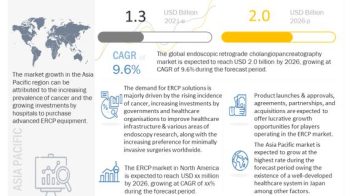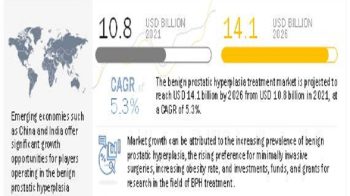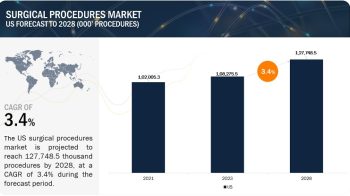According to the new market research report, “Brain Monitoring Market by Product (Accessories, MRI, CT, PET, EEG, EMG, MEG, ICP, Electrode, Paste, Gel, Battery, Cable, Invasive), Disease (TBI, Stroke, Dementia, Epilepsy, Headache, Sleep) & End User (Hospital, Clinic, ASC) – Global Forecasts to 2026” The global brain monitoring market size is projected to reach USD 8.0 billion by 2026 from USD 5.8 billion in 2021, at a CAGR of 6.5%.
Download PDF Brochure@
https://www.marketsandmarkets.com/pdfdownloadNew.asp?id=909
Global Industry Growth Boosting Factors:
The brain monitoring market is mainly driven by factors such as the increasing incidence and prevalence of neurological disorders, rising awareness of neurodegenerative diseases, growth in the number of traumatic brain injuries, and growing applications of brain monitoring in clinical trials. On the other hand, the high cost of complex brain monitoring procedures and devices, unfavorable reimbursement policies, and the shortage of trained professionals to effectively operate brain monitoring devices are restraining the growth of this market.
Overview:
This study involved four major activities in estimating the size of brain monitoring market. Exhaustive secondary research was done to collect information on the market, peer market, and parent market. The next step was to validate these findings, assumptions, and sizing with industry experts across value chains through primary research. The bottom-up approach was employed to estimate the overall market size. After that, market breakdown and data triangulation were used to estimate the market size of segments and sub-segments.
Driver: Increasing incidence and prevalence of neurological disorders
The global incidence and prevalence of neurological disorders, such as dementia, epilepsy, Parkinson’s disease, Huntington’s disease, headache disorders, multiple sclerosis, neuro infections, stroke, and cerebral palsy, have increased significantly over the years. Brain disorders, which include a combination of developmental, psychiatric, and neurodegenerative diseases, are a growing cause of morbidity across the globe. This can primarily be attributed to the growing geriatric population (by 2050, more than 20% of the global population is expected to be aged over 65 years). The American Medical Association (AMA) estimates that at least 60% of individuals aged 65 years and above will be living with more than one chronic condition by 2030.
Request Sample Pages@
https://www.marketsandmarkets.com/requestsampleNew.asp?id=909
Restraint: Research High cost of complex brain monitoring procedures and devices
The high cost of brain monitoring surgeries and devices is a major factor restraining the global brain monitoring market, especially in developing countries with poor reimbursement policies. Brain monitoring devices are highly complex, and the procedures involving the use of these devices are generally expensive. For instance, the average cost of a standard EEG is ~USD 200–700; this procedure can cost as high as USD 3,000 for extended monitoring. A dual-channel TCD costs approximately USD 3,000–3,200, and an ICP monitor costs approximately USD 340–500. Likewise, a single MEG system costs roughly USD 2.5–3 million. Due to the high price, healthcare facilities, even in countries that show wide adoption of high-tech medical equipment, find it difficult to procure MEG devices. Additionally, the maintenance cost and other associated indirect expenses increase the total cost of ownership of these devices, thereby limiting their adoption.
Opportunity: The increasing demand for non-invasive and minimally invasive devices
Invasive monitoring is a complex, painful, and risky process, as it involves direct intervention with sensitive brain tissue. Doctors and patients, therefore, show a high inclination toward the use of non-invasive or minimally invasive brain monitoring devices. Owing to their advantages, there has been a rapid increase in the demand for non-invasive ICP monitors, TCD devices, tympanic membrane displacement procedures, optic nerve sheath diameter, CT scan/MRI, and fundoscopy, which are reliable alternatives to invasive techniques, thus compelling players in this market to develop and commercialize such products.
In March 2019, Masimo (US) received CE Mark approval for its next-generation SedLine brain function monitor for pediatric patients aged between one and 18 years of age; this product assesses the brain function while the patient is under anesthesia.
By end user type, the hospital segment accounted for the largest share 57.8% of the brain monitoring market in 2020.
Based on end-users, the global brain monitoring devices market is segmented into hospitals, neurology centers, diagnostic centers, ASCs & clinics, and other end users. The hospital segment held the largest share 57.8 % of the global brain monitoring market in 2020. Brain monitoring is a complex process, requiring expensive and advanced devices and equipment that are mainly found in hospitals. Hospitals also see a considerably larger inflow of patients as compared to small clinics and other end users. Additionally, brain monitoring devices pose a considerable burden in terms of maintenance expenses on healthcare facilities; hospitals, more than other end-users, can bear such costs. Hence, brain monitoring devices are mostly used in hospitals, which consequently account for the largest share of this market segment.
Speak to Analyst for More Detailed Information@
https://www.marketsandmarkets.com/speaktoanalystNew.asp?id=909


